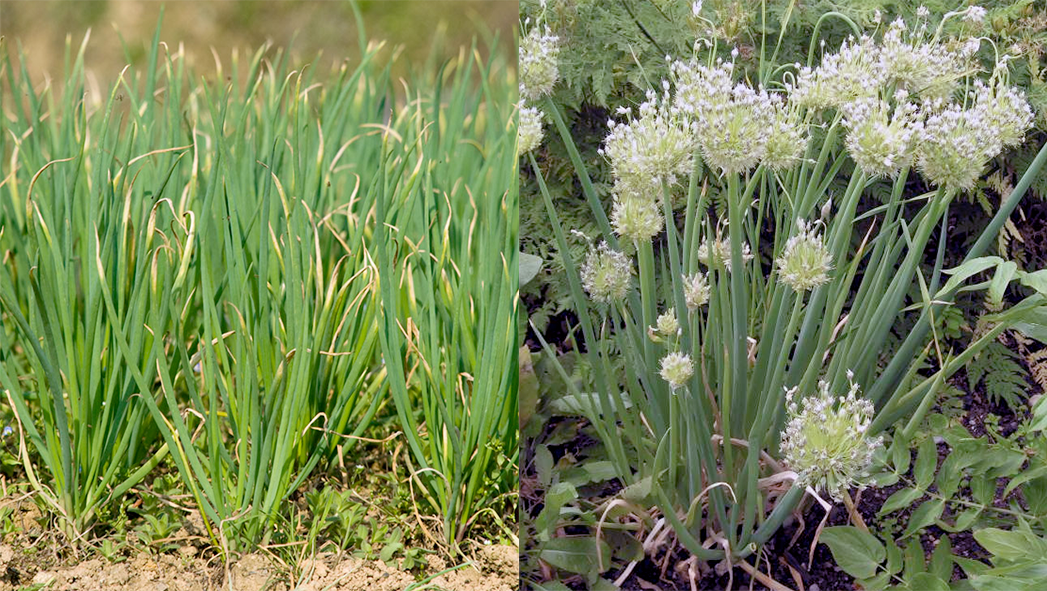 Branching onions
Allium
fistulosum in
cultivation in China
and in flower in a
Japanese garden.
Branching onions
Allium
fistulosum in
cultivation in China
and in flower in a
Japanese garden.
Welcome to the summary page for FabulousFusionFood's Herb guide to Branching Onion along with all the Branching Onion containing recipes presented on this site, with 20 recipes in total.
e This is a continuation of an entire series of pages that will, I hope, allow my visitors to better navigate this site. As well as displaying recipes by name, country and region of origin I am now planning a whole series of pages where recipes can be located by meal type and main ingredient. This page gives a listing of all the Cornish recipes added to this site.
These recipes, all contain Branching Onion as a major herb flavouring.
Branching onions, Allium fistulosum (also known as Welsh onion, bunching onion, long green onion, Japanese bunching onion, bunching shallot, cibol, cives and spring onion) is a species of perennial plant, often considered to be a kind of scallion It is a member of the Amaryllidaceae (Amaryllis) family).
The species is very similar in taste and odour to the related common onion, Allium cepa, and hybrids between the two (tree onions) exist. A. fistulosum, however, does not develop bulbs, and its leaves and scapes are hollow (fistulosum means "hollow"). Larger varieties of A. fistulosumA. fistulosum can multiply by forming perennial evergreen clumps. It is also grown in a bunch as an ornamental plant.
It is native to China, though cultivated in Eurasia and North America (particularly the Caribbean). The epithet 'Welsh' comes from the Anglo-Saxon root wealh- meaning foreign or non native (cf Welsh or Walloon) and survived in Botanical nomenclature to mean the same. A. fistulosum is an ingredient in Asian cuisine, especially in East Asia and Southeast Asia. It is particularly important in China, Japan, and Korea, hence one of the English names for this plant, Japanese bunching onion. It is also a key flavouring in French Antillean cuisine where it is known as cive (often mis-translated as 'chives'). In the West, A. fistulosum is primarily used as a scallion or salad onion, but is more widely used in other parts of the world, particularly East Asia. Known as escallion it is an ingredient in Jamaican cuisine and is often added to dry spice mixtures.
e This is a continuation of an entire series of pages that will, I hope, allow my visitors to better navigate this site. As well as displaying recipes by name, country and region of origin I am now planning a whole series of pages where recipes can be located by meal type and main ingredient. This page gives a listing of all the Cornish recipes added to this site.
These recipes, all contain Branching Onion as a major herb flavouring.
Branching onions, Allium fistulosum (also known as Welsh onion, bunching onion, long green onion, Japanese bunching onion, bunching shallot, cibol, cives and spring onion) is a species of perennial plant, often considered to be a kind of scallion It is a member of the Amaryllidaceae (Amaryllis) family).
The species is very similar in taste and odour to the related common onion, Allium cepa, and hybrids between the two (tree onions) exist. A. fistulosum, however, does not develop bulbs, and its leaves and scapes are hollow (fistulosum means "hollow"). Larger varieties of A. fistulosumA. fistulosum can multiply by forming perennial evergreen clumps. It is also grown in a bunch as an ornamental plant.
It is native to China, though cultivated in Eurasia and North America (particularly the Caribbean). The epithet 'Welsh' comes from the Anglo-Saxon root wealh- meaning foreign or non native (cf Welsh or Walloon) and survived in Botanical nomenclature to mean the same. A. fistulosum is an ingredient in Asian cuisine, especially in East Asia and Southeast Asia. It is particularly important in China, Japan, and Korea, hence one of the English names for this plant, Japanese bunching onion. It is also a key flavouring in French Antillean cuisine where it is known as cive (often mis-translated as 'chives'). In the West, A. fistulosum is primarily used as a scallion or salad onion, but is more widely used in other parts of the world, particularly East Asia. Known as escallion it is an ingredient in Jamaican cuisine and is often added to dry spice mixtures.
The alphabetical list of all Branching Onion recipes on this site follows, (limited to 100 recipes per page). There are 20 recipes in total:
Page 1 of 1
| Bébélé (Tripe and Plantain Stew) Origin: Guadeloupe | Court-bouillon de Poisson à la Créole (Creole-style Fish Court-bouillon) Origin: Guadeloupe | Mousseline de fruit à pain (Breadfruit mousseline) Origin: Martinique |
| Blaff de poisson (Fish Blaff) Origin: Guadeloupe | Dombrés de Morue Salé (Salt Cod Dombres) Origin: Martinique | Ouassous dans la nage (Ouassous in the swim) Origin: Guadeloupe |
| Blaff de poisson (Fish Blaff) Origin: French Guiana | Dombrés haricots rouges (Red Bean Dombrés) Origin: Guadeloupe | Poulet Boucané (Buccaneer/Smoked Chicken) Origin: Martinique |
| Boudin Créole (Creole Black Pudding) Origin: French Guiana | Dombrés Poulet (Chicken Dombres) Origin: Martinique | Ragoût de cabri créole (Creole Goat Stew) Origin: Guadeloupe |
| Boudin Créole Rouge (Creole Black Pudding) Origin: Guadeloupe | Dongouésde bananes plantain à la morue et lait de coco (Plantain Dongoués with Salt Cod and Coconut Milk) Origin: Martinique | Ragoût de chatrou créole (Creole Chatrou Stew) Origin: Guadeloupe |
| Chaudage (Pork and Beef Stew) Origin: Guadeloupe | Fricassée de Lambi (Queen Conch Fricassee) Origin: Martinique | Z'habitants (Martinique Callaloo) Origin: Martinique |
| Chiquetaille de morue (Cod Chiquetaille) Origin: Guadeloupe | Krill Sweet Potato Cakes Origin: Fusion |
Page 1 of 1